Scottsman Able to Where Tartans Again
Think 'Scotland' and y'all probably imagine 3 things: haggis, bagpipes and kilts. Although these are stereotypes, they undoubtedly form part of the nation's identity and history.The nearly prominent of them all? Information technology has to be the kilt—a standard particular of men'due south Highland Dress. A 'true Scotsman' wears his kilt with pride and accolade every bit it embodies his heritage and tradition. Worn at weddings , christenings and military parades alike, this icon of Scottish wearable endures to this day.
But how much do yous know about the kilt'southward history?
Here at Lochcarron, we fancy ourselves every bit tartan virtuosos. Equally such, we like to think nosotros know our stuff when information technology comes to kilts.
Accordingly, nosotros take compiled a brief history of this unique Scottish garment.
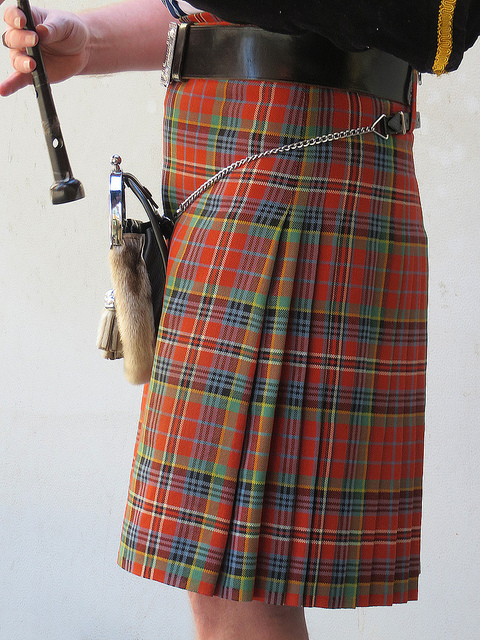 Source: NewTown Grafitti
Source: NewTown Grafitti
What is information technology?
Originating in the traditional wearing apparel of men and boys in the Scottish Highlands in the 16th century is a skirt-type garment with pleats at the rear.
Since the 19th century, the kilt has become associated with the wider Scottish and Gaelic cultures.
Kilts are often made of a woollen material in a tartan pattern .
Normally worn at formal events, competitors as well habiliment this Scottish outfit at the Highland Games . Taking place in an array of islands, towns, villages and cities beyond the nation, these heavy athletics, dancing, rails and field tournaments are held every weekend in the Scottish summer.
The kilt has recently been adjusted into an particular of contemporary mode wear, highlighting the versatility of this age-old detail of wear.
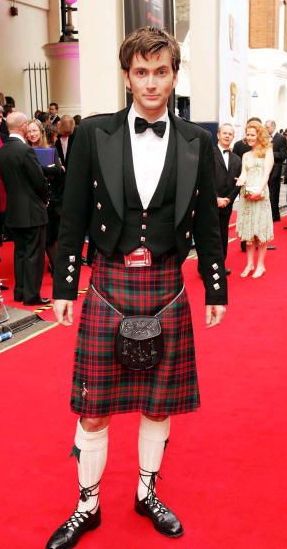 Source: Wikimedia eatables
Source: Wikimedia eatables
Its Origins
Known as the Scottish national dress, kilts are recognised the world over. A symbol of patriotism and national identity, they have deep-seated cultural and historical roots. Across the globe, Scottish people proudly sport kilts as a tribute to their heritage.
Yet, this wasn't always the instance.
For many years, entirely confined to the Highlands, the kilt was widely considered the garb of savages. The Lowlanders, who make up the majority of Scots, regarded this class of apparel equally barbarous. They viewed those who wore it with contempt and loathing, labelling them with the derogatory term: 'redshanks'.
The etymology of the word 'kilt' dates dorsum to the Scots word 'kilt', which ways to constrict dress around the body. However, the Encyclopædia Britannica says the Scots word is Scandinavian in origin, deriving from the Ancient Norse, 'kjalta', pregnant pleated.
The question is: how did these tartan skirts evolve?
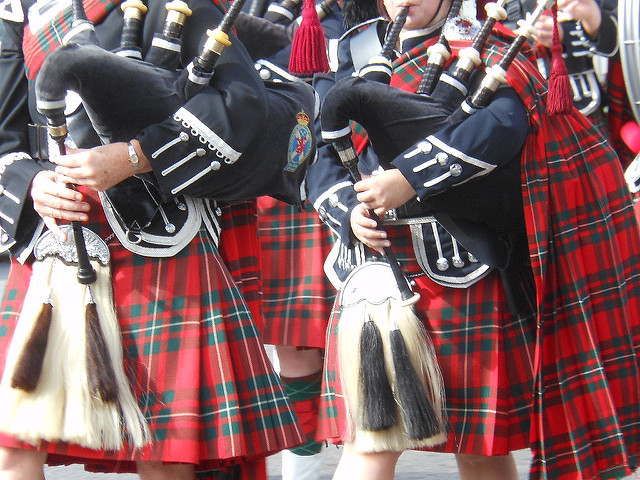 Source: Michael Coghlan
Source: Michael Coghlan
How did the information technology evolve?
The kilt, like most items of wear, has undergone a process of evolution over the centuries. Starting life as the 'great kilt', the kilt we recognise today (the small kilt) has its roots in the late 1600s.
The history of the kilt, itself, stretches dorsum to at least a century before.
The peachy kilt
At the end of the 16th century, the kilt first appeared as the belted plaid ( Breacan an Fhéilidh ) or peachy kilt ( Feileadh Mòr ) : a full-length garment whose upper half could exist worn as a cloak draped over the shoulder or brought over the head as a hood.
Owing to the choppy atmospheric condition and treacherous terrain of the Scottish Highlands, the belted plaid had many advantages. It was warm, it allowed liberty of motion, the upper half served as a cloak against the atmospheric condition, it dried out quickly and it could provide adequate over-nighttime blanketing. Y'all may be familiar with this early version of the kilt from the award-winning film: Braveheart , directed by and starring Mel Gibson—whose character, William Wallace, a staunch patriot and defender of Scottish freedom, proudly dons a belted plaid to exhibit his delivery to the Scottish cause.
However, this depiction is grossly inaccurate as the great kilt did non come into existence until around 300 years afterward Wallace's death.
Still, it gives you lot an thought of what this big coating-similar slice of fabric looks like.
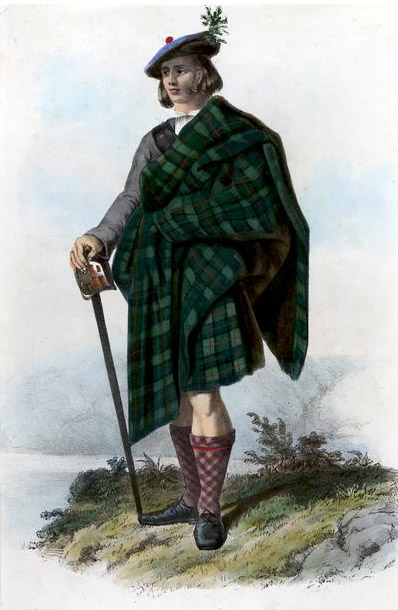 Source: Wikimedia commons
Source: Wikimedia commons
The Small Kilt
The knee-length tartan kilt we are familiar with today closely resembles the pocket-size kilt or walking kilt, which did not develop until the late 17th or early 18th century.
Essentially the bottom one-half of a keen kilt, the pocket-sized kilt or walking kilt ( fèileadh beag ) became popular in the Highlands and northern Lowlands by 1746, although the great kilt (or belted plaid) continued to be worn.
The design of the small kilt was adopted by the Highland regiment of the British Regular army, the military kilt then passed into civilian usage and has remained popular ever since.
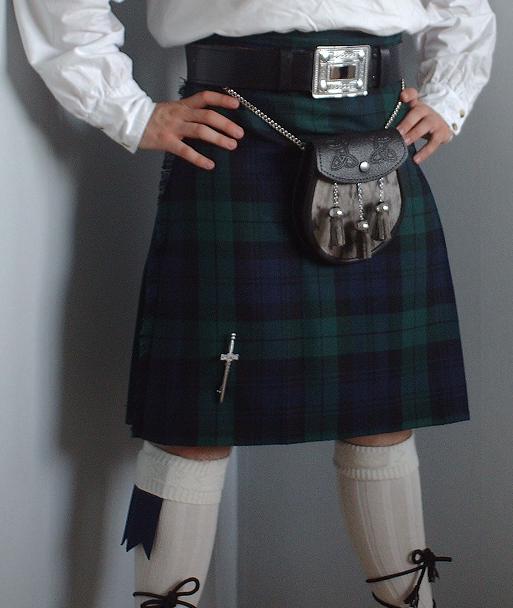 Source: Wikimedia commons
Source: Wikimedia commons
Who invented the kilt?
Rawlinson
Although non without controversy, a letter published in the Edinburgh Magazine attributes the advent of the modern-day kilt to Thomas Rawlinson, a Quaker from Lancashire. Rawlinson, an English Ironmaster, 'man of genius and quick parts', employed Highlanders to work at his furnaces near Inverness.
Initially, his workers wore the great kilt. However, Rawlinson accounted the belted plaid too 'cumbrous and unwieldy' for smelting fe ore and manufacturing charcoal. On the grounds of efficiency and practicality, he designed a kilt, comprising the lower half of the belted plaid, to human activity every bit a distinct garment with pleats already sewn. The small-scale kilt or walking kilt was built-in.
Rawlinson and his concern partner, Ian MacDonnell (master of the MacDonnells of Glengarry), wore the kilt themselves, with the clansmen following their principal's example.
The tartan skirt-like garment shortly became a fashion hit.
Notably, Rawlinson's kilt is the earliest documented example of a minor kilt with sewn-in pleats, which are a distinctive characteristic of today's kilt.
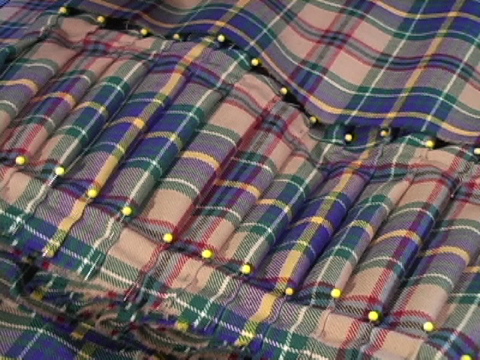 Source: Wikipedia commons
Source: Wikipedia commons
Before Rawlinson
Of form, many Scots dispute the notion that an Englishman invented the kilt. Indeed, in that location is some evidence to suggest that the kilt was in use before Rawlinson's time. For example, the portrait of Kenneth Sutherland, third Lord Duffus , appears to point to earlier use of the walking kilt. All the same, there are discrepancies concerning this theory among the Historiographical community, with some experts disagreeing every bit to the origins of the mod-twenty-four hours kilt.
Michael Fry, an eminent Scottish historian, debunked Lord Dacre's claims about the kilt proverb they 'prove absolutely zero'. Fry claims at that place is testify that Tartan was worn in the Middle Ages—he also labelled Lord Dacre as 'not a very reliable guide to Scottish history.'
Equally with whatever example of history, the accounts of who invented the iconic symbol of Scotland is inconsistent.
Which account do yous think is virtually plausible? Either way, the debate surrounding this contentious and patriotically-charged issue continues.
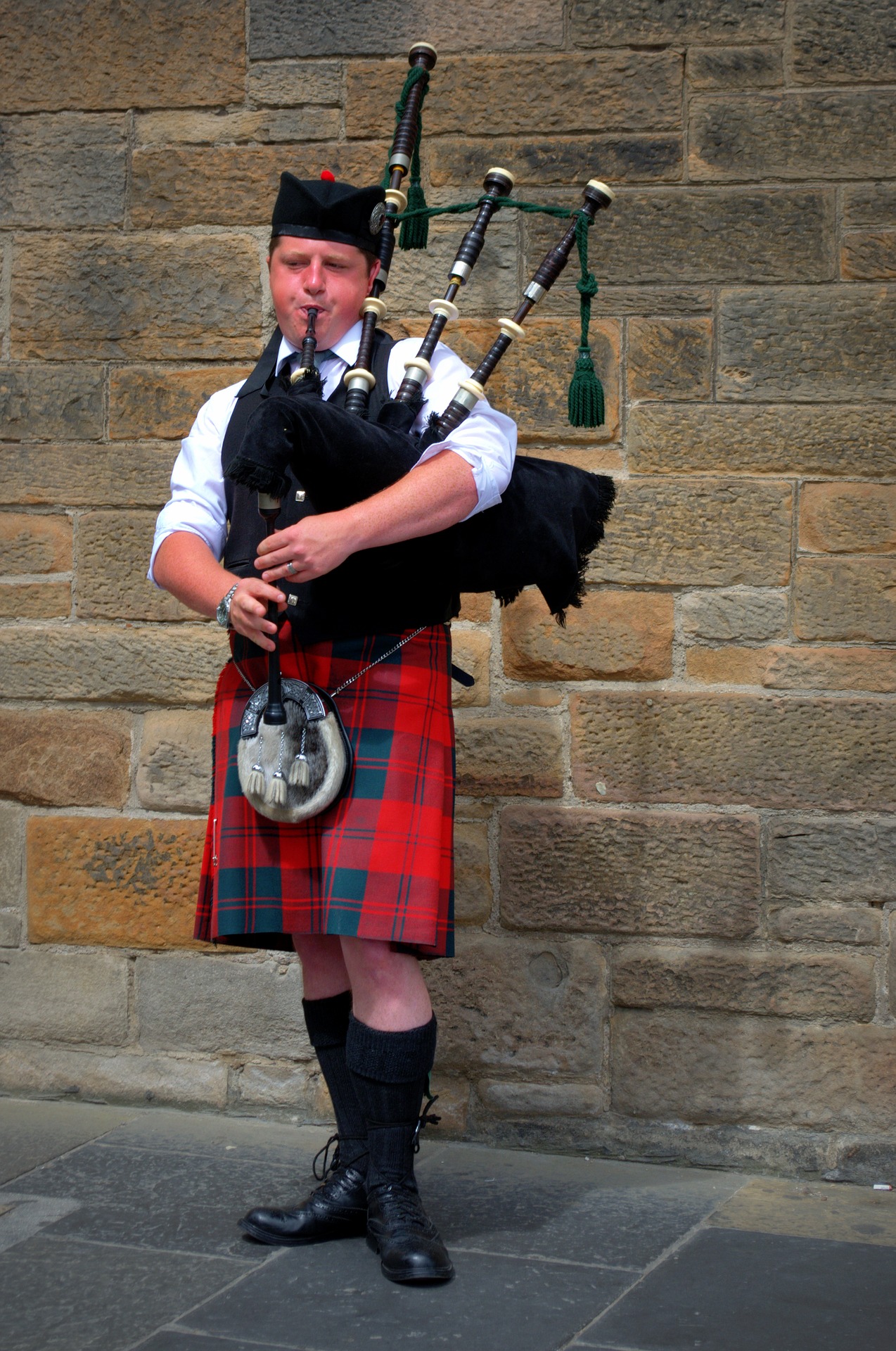
Source: Bernhard_Staerck
The Dress Act 1746
In 1746, not long after the kilt's invention, all items of Highland Dress, including the kilt, were outlawed by the Dress Human action (or Diskilting Act).
In the wake of the Jacobite Uprising, to avoid the encarmine battles of the past , the deed was passed in an effort to suppress Highland culture and bring warrior clans nether authorities command .An exception was fabricated for the Highland Regiments of the British Ground forces—each of which was given different tartans then they could be identified.
Anyone who defied the ban was sentenced to six months' imprisonment for their first offence. For their second, they were to exist transported to any of His Majesty'due south plantations beyond the body of water, there to remain for the infinite of 7 years.'
During the ban, it became stylish for Scottish romantics to wear kilts equally a form of protest.
1782
In 1782, cheers to the efforts of the Highland Society of London, the Diskilting Act was repealed. By that time, kilts and tartans were no longer ordinary Highland wear, paving the manner for new interpretations of Highland Dress.
With this, a new persona of the Highlander was conceived. No longer bare-legged, dangerous barbarians, they became admirable, kilted versions of the 'noble fell'.
This romanticized vision of Scottish Highlanders was a reaction to the urban and the industrial and a celebration of the untamed wilderness.
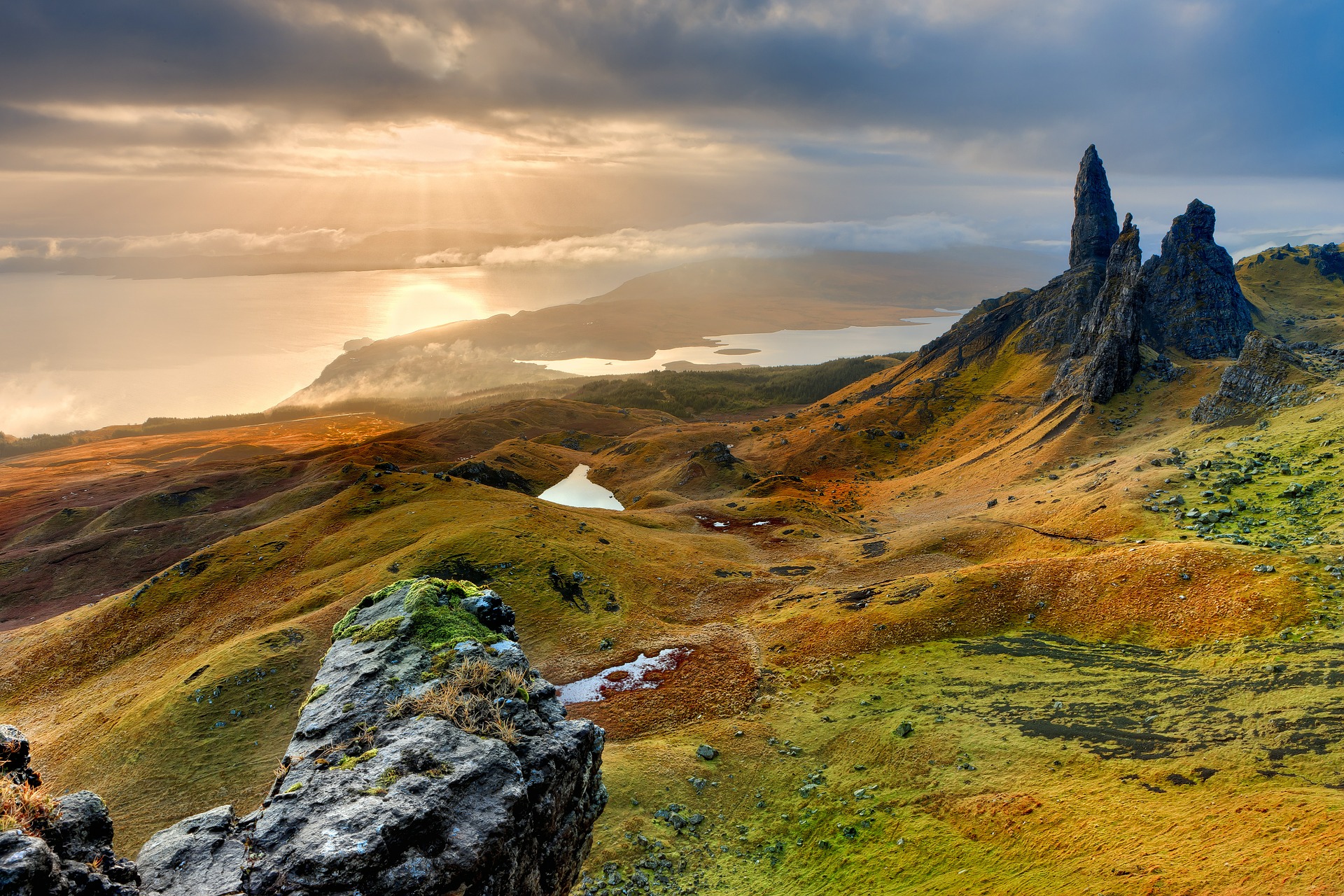 Source: FrankWinkler
Source: FrankWinkler
Types of kilt
We all know the kilt for its vibrant tartan designs . But throughout history, not everyone who wore ane could afford such adorned patterns.
Historical Scottish clothes were worn depending on the wealth of the wearer. They were either coloured in various bank check tartan designs or apparently wool.
Many original wearers could not beget to buy elaborate designs. Afterwards all, this Scottish traditional dress was a largely practical form of habiliment (not ceremonial every bit it is considered today).
Here are some more examples:
- The traditional garment, either in its historical course or the modern adaptation now commonly institute in Scotland
- The Irish kilt worn by Irish piping bands, but in a single (solid) color
- Various school uniforms for girls
- Variants of the Scottish kilt developed in other Celtic nations, such equally the Welsh cilt and the Cornish cilt
Let's take a closer look at the Scottish kilt…
Scotland
Design
The Scottish kilt demonstrates the uniqueness of design, structure, and convention.
A tailored garment, wraps around the wearer's body at the natural waist (betwixt the lowest rib and the hip) starting from 1 side (unremarkably the wearer's left), around the front and dorsum and across the front again to the opposite side.
This design comprises the modernistic-mean solar day kilt ordinarily seen worn at formal events, military parades and the Highland Games.
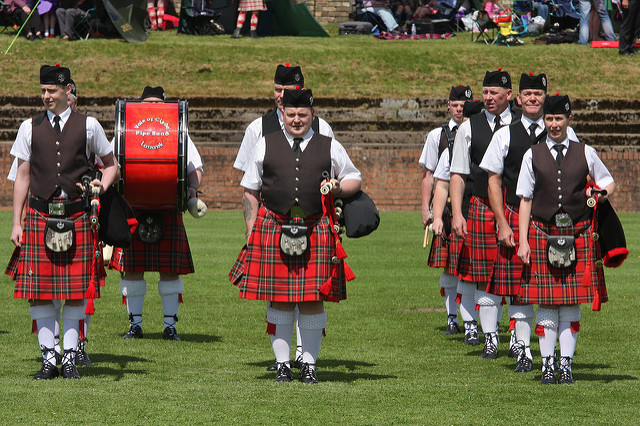 Source: Ian Robertson
Source: Ian Robertson
Fabrics
A traditional Scottish kilt is made from worsted wool with a twill structure. This creates a distinctive diagonal-weave pattern in the fabric. When woven in a particular sett or colour design is called tartan.
That's where we come in. As tartan virtuosos, we provide iii different weights , all of which serve a unlike purpose.
These days, there are many ways to use tartan in DIY arts and crafts .
Setts
Maybe the nigh striking characteristic of the authentic Scottish kilt is the tartan pattern, the sett, information technology exhibits. The association of detail patterns with individual clans or families can be traced dorsum centuries.
Today at that place are particular tartan patterns for organisations, societies, districts and counties. There are besides setts for universities; schools; sporting activities and individuals.
Underwear: to wear or non to wear?
It is often rumoured that a 'truthful Scotsman' wears zilch underneath his kilt.
Craig Murray, writing for the Contained, explains 'the reason is that it is very warm and cosy swathed in all that pure wool. If annihilation, it gets too hot down there. Underpants would simply be – well, glutinous.' The Scottish Tartans Authority , on the other manus, argues that the practice could be regarded equally ' kittenish and unhygienic' and that "'going commando' flies in the face up of decency."
Traditional Scottish Dress Today
You may take spotted men wearing kilts as an alternative to trousers at formal events similar weddings, christenings, and graduations. In that location are even fashion versions of the garment bachelor for women in mini-skirt grade.
Kilts are also worn at Hogmanay (Scottish New year) and the Highland Games.
The Kilt is a long-continuing and much-respected emblem of Scotland. Therefore, it's only right that it'due south rich history is remembered and historic.
Shop Kilts Here
murraypritioneatch.blogspot.com
Source: https://www.lochcarron.co.uk/our-journal/the-history-of-the-kilt/
0 Response to "Scottsman Able to Where Tartans Again"
Post a Comment